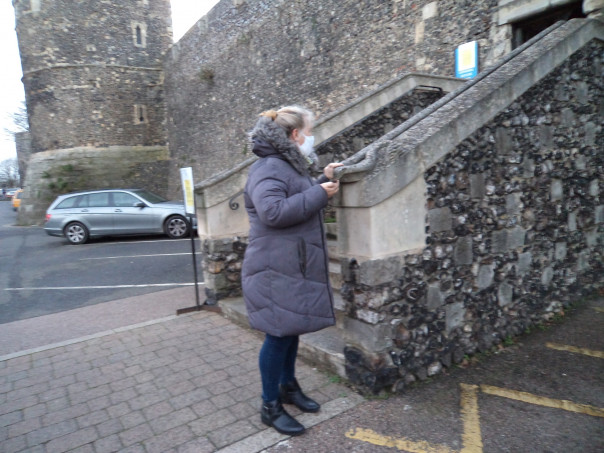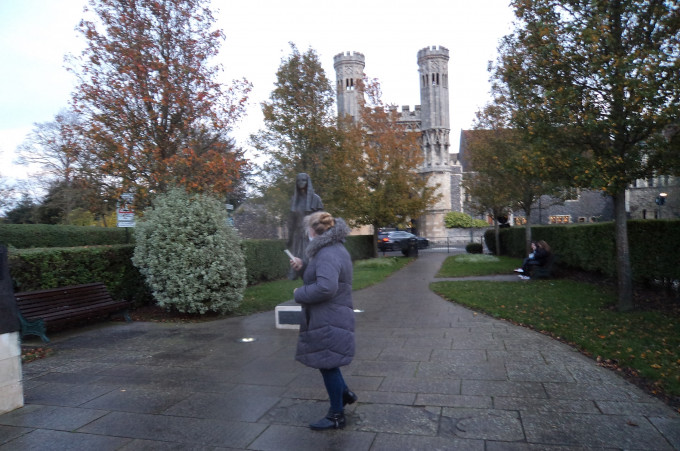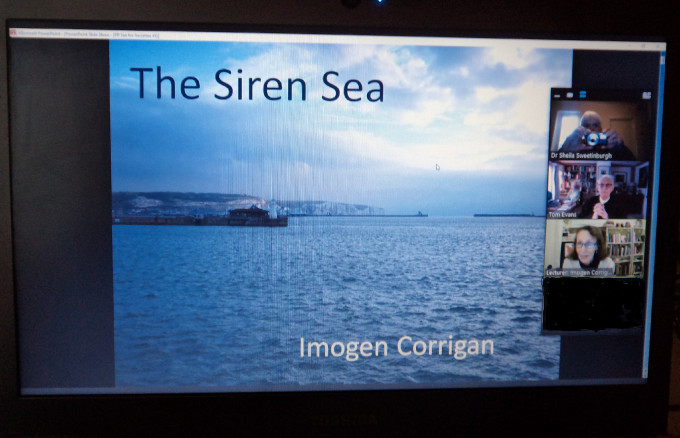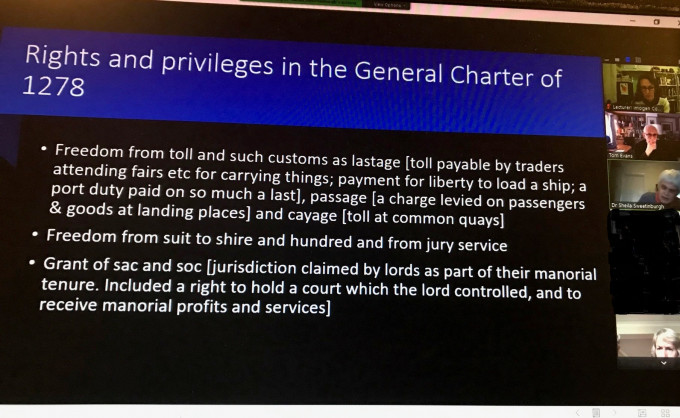I will come to Jane’s presentation for the meeting of the Kent History Postgraduates Group shortly, but first I wanted to let you know about a few other matters involving Centre staff, including, of course, the Kentish Book Culture book launch (see last week for the booking url). Furthermore, Dr Diane Heath has just heard that she can apply again to the HLF because they have just reopened for bids, having closed suddenly last March. This means Diane can revive her ‘Medieval Animals’ project, and she has been talking again to her external partners, and will do so more fully this week with the intention of applying for a grant very shortly.

Another project involving Diane is Paul Carney’s ‘Walkie Talkies’. As Director of Sport & Active Health, Paul is keen to promote the health and wellbeing advantages of walking, and to further this he has enlisted the help of various groups and individuals across the university to undertake informative walks to be turned into podcasts. We met up with him on Teams last week and then last Saturday afternoon Diane and I, with Poppy Diane’s dog, walked a section of Canterbury city wall from Queningate to Canterbury Castle and St Mildred’s church, stopping at various points to record some, we hope, interesting material about the route and what you can see. However, I did forget to mention that we might have been walking in the footsteps of at least one bear in that the walls in Tudor times were sometimes used by the owners of bears to exercise (illegally) their charges.
Having competed this walk and stopped for a coffee in the Dane John gardens, we did Diane’s walk which followed (broadly) in the footsteps of Queen Bertha from Queningate, her route out from the presumed royal residence in the inner burg, to St Martin’s church. This took in Lady Wootton’s Green, St Augustine’s Abbey cemetery gate (into the medieval lay cemetery), Longport, the campanile mound, the Anglo-Saxon (c.580) aristocratic female burial, and St Martin’s church. By which time Poppy had had enough of historic Canterbury!

Our Saturday afternoon expedition was after I had spent the morning online with the Tenterden U3A. This excellent group organise an annual study morning and this year have been extremely enterprising to go online. Thus, “Ready for to Go to Sea”: Cinque Ports, Sailors and Our Maritime Past, which featured a great lecture by Imogen Corrigan on ‘The Siren Sea’, was followed by my presentation on ‘The Cinque Ports in the Middle Ages’. I’m sure Imogen is well known to many readers of the blog, not least because she is a stalwart of the Centre’s History Weekends, having given a lecture every year since 2016 and would have been presenting if our Medieval Canterbury Weekend had taken place in April 2020.
For her lecture last Saturday, among the many highlights were her discussion of the perils of sailing into the unknown, blown well beyond land and having to navigate using the stars and ‘magical’ lodestones, which because of their magnetism could be used to find the north. She also discussed which saint was best to call on depending on the conditions experienced, although one assumes not everyone had got this right in the past. So shipwreck could be seen as an ever present danger for those setting out to sea, and, as Imogen explained, perhaps the worst such disaster to take place in terms of medieval England was the loss of the White Ship. When this went down, it took with it almost everybody, including Henry I’s only son and heir, which, of course, would lead to a time when “God and his saints slept” in England during the civil war between the Empress Matilda and her cousin Stephen.

In comparison my talk didn’t include such disasters, unless you count the Cinque Portsmen’s ability at times to back the wrong side at times of civil war or revolt. But saying this, they did very nicely out of Henry III getting the Head Ports’ General Charter of 1278 that details the hard-won rights and privileges they had acquired. It was against this background that I then explored the Portsmen’s maritime activities as fishermen, as carriers of goods (and people), sometimes for themselves but often for others – facilitators of trade, and as pirates, albeit that might be officially condoned and sometimes even encouraged during wartime. Thus, we explored the rise and fall of ‘King Herring’, the enterprise of French ale-wives who might be said to have exploited cross-Channel drinking habits, and the Portsmen’s support for Warwick the Kingmaker when he ‘ruled’ Calais and the Narrow Seas, less out of loyalty for the crown and more out of self-interest as he (and they) was not averse to a spot of privateering.
After the presentations, there were a number of questions from the 140 plus audience, and as far as I could tell people had enjoyed the morning, albeit hopefully next autumn it will be back in the hall! I should, therefore, like to thank the organisers, especially Tom Evans, Lindy Bates and Jenny Stevens, and I’m very grateful for the contribution to the Ian Coulson Memorial Postgraduate Award fund to help those who want to research Kent history topics.

Although I am going to save the activities of the Lossenham history group for another time, I thought I would just mention that we had our second meeting on Monday. We were online this time, and the plan is to have an open online meeting for people who may want to become volunteers – archaeology and history – on Tuesday 15 December at 7pm (using Zoom), with an online workshop for history volunteers on Tuesday 23 February, again at 7pm – more details shortly.
This brings me to the Kent History Postgraduate Group meeting where we welcomed three new members. Unfortunately due to technical problems, I missed the first part of the meeting where Lisa, a well-established archaeology doctoral student, and Grace and Rich, two new archaeology research students met everyone else except Lily and Maureen who were unable to make it. However, I did get online, just, for Jane’s presentation. To provide background information for those not conversant with late medieval and Tudor will-making and the proving of such documents in the church courts, Jane provided a very clear summary of the hierarchical nature of church courts across England and Wales, and thus where a specific testator’s will would have been proved.

Next she described how this affected the diocese of Rochester, where her study is based. At the top of the hierarchy were the Prerogative Court of Canterbury (PCC) wills for those with the most geographically extensive landholding, albeit some of these testators belonged to the yeomanry ie 15th-century peasant farmers with relatively large, dispersed holdings. Below them were those whose wills would be proved in the bishop of Rochester’s court – the consistory court; and below again were those whose wills ended up in the archdeaconry court – Rochester having the deaneries of Rochester, Dartford and Malling. Additionally, for those from certain mainly west Kent parishes (a total 34 parishes), their wills were likely to be proved in the archbishop of Canterbury’s court for this ‘peculiar’ (the deanery of Shoreham). Now you may wonder why all of this matters, but these will collections are held in different record offices, and for some categories nothing survives at all. Thus, the PCC wills are at The National Archives (TNA) at Kew, the original registers of the Rochester Consistory Court are at the Kent History & Library Centre (KHLC), Maidstone, but there are micro-film copies at the Medway Archives. The registers for the Rochester Archdeaconry Court are not complete which is a loss because in terms of numbers this would have been the largest collection for the Rochester diocese, as it is for Canterbury, and the Shoreham Deanery registers are at Lambeth Palace Library, with microfilm copies at KHLC.
With this context, Jane then introduced her case study, the will of Sir Thomas Culpeper, knight. Currently she has not had an opportunity to consult the will in full because it is held at Lambeth, but there is an extract on the Kent Archaeological Trust website among a collection of such Rochester diocesan extracts. As members of the upwardly mobile lower nobility, the family held Bayhall, Hadreshull and Exton, while their patronage and local largesse had led to an ancestor, John Culpeper, building the parish church of neighbouring Pembury in the early 14th century. The advowson of this church had been given to Bayham Abbey, a link Sir Thomas wished to maintain through personal relations expressed through post-mortem monetary gifts to the abbot (although not named), every canon, and the abbot and convent as a whole.

However, the greatest marker of regard between Sit Thomas and his chosen religious house was probably his desire to be buried in an alabaster tomb alongside his wife, who seems to have predeceased him, in Bayham Abbey church. For the early 15th century such tomb-making was a major undertaking and seems to say much about this locally important family, as well as Thomas’s desire to seek commemoration and the apparent willingness of the abbot to foster such ties through the tomb being very close to one of the altars in the abbey church, most probably in the chancel. This prestigious position was also to be the site of Culpeper’s temporary chantry which was to aid the souls of Thomas and Joyse his wife.
Although not the only religious house Thomas supported, there are differences in the relationship Thomas was seeking with Tonbridge Priory, one of Jane’s other religious houses, for it was to receive 20s with no suggestion of personal ties, rather the actions of an orthodox pious individual who was seeking to maintain his and his family’s position beyond the grave.
I’ll leave aside Culpeper’s desire for post-mortem pilgrimages on his behalf; and conclude by saying that Jane’s presentation demonstrated the value of wills as a source for such qualitative analysis. She also mentioned how by putting information from these wills onto a database, she will be able to analyse her sources quantitatively, which sparked a discussion about the alternatives to Microsoft Access as a way to keep the richness of such sources. So concluded our first meeting with this new larger group, and it will be great to bring everyone together in a fortnight’s time.
 Centre for Kent History and Heritage
Centre for Kent History and Heritage Sheila Sweetinburgh
Sheila Sweetinburgh 1403
1403

